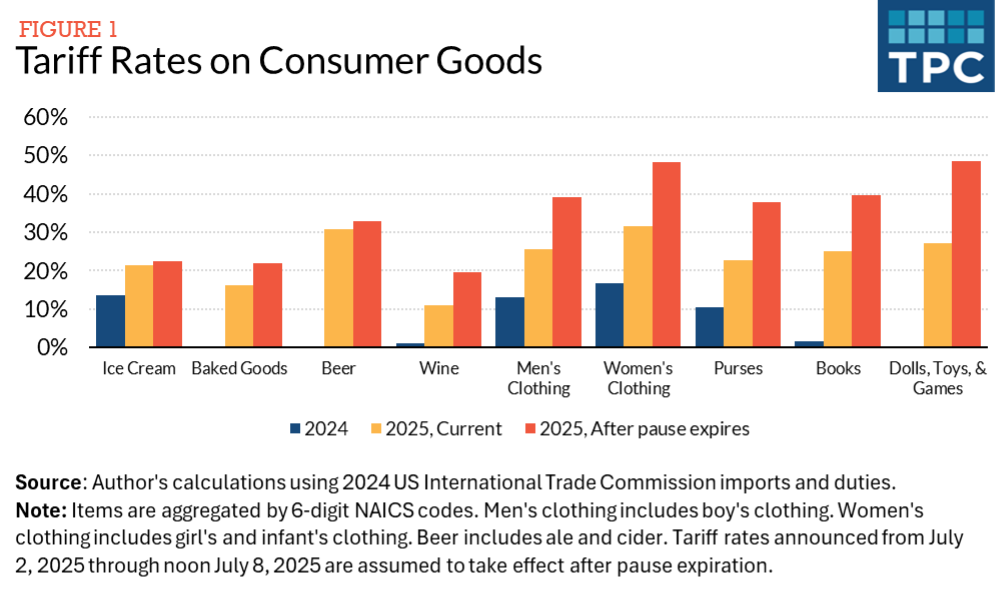Tariffs Vs. Bitcoin: How Crypto is Reacting to Trump’s Trade War Economy
0
0

Trump’s tariff reversals continue to create upheaval across financial markets, and there are no signs of stopping. Many are weary of the predicted slowdown in economic activity throughout the third quarter of 2025.
Unlike traditional markets, crypto has shown a different trajectory. Specifically, Bitcoin has decoupled from news regarding tariffs. According to Kronos Research’s CEO, cryptocurrency is expected to contribute to easing trade uncertainty for individuals and businesses alike.
Tariff Twists and Turns
President Trump’s trade policy in 2025 has been characterized by a recurring pattern of tariff threats decorated with reversals and extensions.
On Monday, President Trump announced reciprocal tariffs targeting 14 countries, with rates between 25% and 40%. He also extended a pause on broader tariffs until August. Further negotiations are expected, with a mid-July deadline for potential trade deals.
“Global trade talks feel fragmented, with the US demanding more while constantly shifting its stance,” Huang told BeInCrypto.
In some cases, President Trump’s pushback proved effective. Last week, Canada immediately rescinded its Digital Services Tax (DST)—a 3% levy on digital revenues generated within its borders—the day after the United States abruptly suspended all trade negotiations with the country.
This move was met positively by traditional financial markets, with the Dow Jones Industrial Average and Nasdaq Composite seeing gains and the S&P 500 reaching a new record high. The Canadian Dollar also remained relatively steady against the US Dollar.
While some see these latest announcements as leverage in ongoing negotiations rather than a direct escalation, significant volatility persists. Much of it has created immense uncertainty for businesses globally.
The Escalating Costs on Consumers and Businesses
Among several aspects of Trump’s trade policy, the lingering 10% minimum tariff rate on most US imports directly relates to higher consumer costs and reduced business profits. This levy, three to four times higher than pre-2025 rates, has created a much more restrictive environment than businesses were accustomed to.
“The current baseline tariff is a major economic drag. It raises costs for businesses, squeezes profits, and drives up prices for consumers,” Huang said.
This significant increase represents a seismic shift for consumers and business owners alike. Many companies rushed to stockpile products, parts, and other imports after the Trump administration’s initial tariff announcement on Canada, China, and Mexico in February.
Still, these precautionary measures can only go so far.
According to the Tax Policy Center, the latest tariffs are set to skyrocket in early August, with rates climbing to 48% on women’s clothing, 40% on books, and 22% on baked goods.
The Budget Lab at Yale, in turn, calculated that the average tariff rate consumers face has reached 18%, the highest since 1934.
 Impact of tariffs on consumer goods. Source: Tax Policy Center.
Impact of tariffs on consumer goods. Source: Tax Policy Center.
As a result, consumer prices will inevitably rise and profit margins will shrink, with lower- and middle-income households most affected.
“Rising import costs hit every stage of the supply chain, forcing companies to absorb fees or hike prices,” Huang elaborated.
However, amid so much chaos, Bitcoin has been able to resist the normal volatility associated with this degree of uncertainty.
Is Bitcoin Truly Decoupling from Tariff News?
When Trump started his tariff frenzy in February, cryptocurrency markets responded negatively to the inconsistent policy changes. Bitcoin even dipped below $80,000 that month for the first time since November 2024.
However, as trade reversals and policy adjustments continue, Bitcoin has more recently appeared to decouple from the latest trade announcements, with some analysts noting its resilience despite ongoing market volatility.
“Bitcoin is decoupling from tariff news as it’s seen more as a macro hedge than speculation,” Huang told BeInCrypto, adding, “With tariffs fueling inflation and market disruption, investors lean on Bitcoin’s scarcity and decentralization, reducing its sensitivity to short-term trade shifts.”
Following Monday’s announcement of adjusted tariff rates, major US stock indices closed lower. In contrast, Bitcoin’s value did not experience the same news.
Instead, it surged, achieving a new historic peak above $118,000 today.
 Bitcoin price surpasses $118,000. Source: BeInCrypto.
Bitcoin price surpasses $118,000. Source: BeInCrypto.
Meanwhile, the technology behind crypto itself can help individuals navigate a tariff-induced economic panorama.
Blockchain for Supply Chain Resilience
Beyond Bitcoin’s price movements, blockchain technology offers practical solutions for individuals and businesses grappling with market instability.
It can circumvent the cumbersome and opaque traits of traditional supply chains, which are exploited by unpredictable trade policies.
“Blockchain powers supply chain resilience by delivering transparent, immutable on-chain records of every transaction and shipment,” Huang explained, adding, “This real-time visibility helps teams spot bottlenecks, verify provenance, and slash fraud offering a bulletproof solution in a trade-disrupted world.”
Meanwhile, businesses can instantly verify product origins and track goods, ensuring compliance and avoiding costly delays or penalties. This enhanced transparency allows for quicker adaptation to new regulations.
Amid such a turbulent backdrop, people will continue looking for ways to stay above water.
Such a context inevitably makes the technological solutions that prop up cryptocurrency a luring option for those seeing their economic prospects worsen over continued turbulence.
0
0
 Manage all your crypto, NFT and DeFi from one place
Manage all your crypto, NFT and DeFi from one placeSecurely connect the portfolio you’re using to start.







